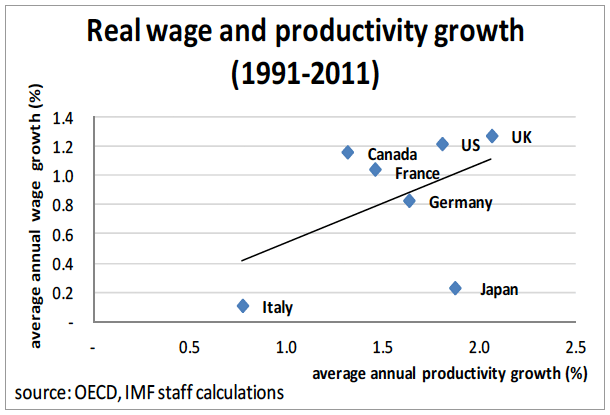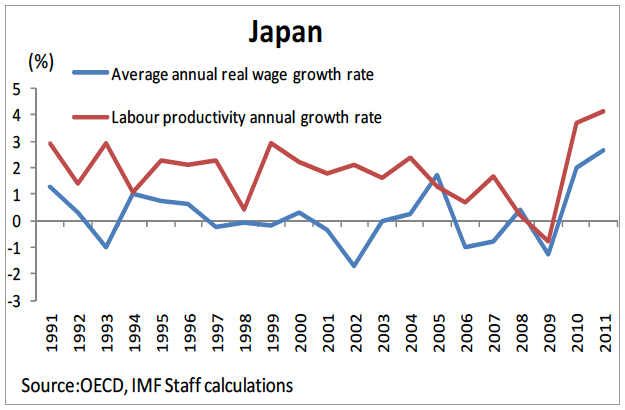An increase in real wages is crucial to generate a virtuous cycle which would allow Japan to exit from deflation. Higher wages would help Abenomics move from its first phase, driven by expansionary monetary and fiscal policies, to a second phase in which growth is led in a sustainable way by the private sector. However, while Japanese earnings are flexible downward, they tend to be rigid upward and do not automatically increase during periods of labor market tightening. As a consequence, real wage growth has been lagging behind productivity growth in Japan for the last two decades. Even during the economic revival of 2002-2008, real wage growth was slightly higher than productivity growth only in two of those years. In this regard, Japan also stands out among the G7 countries (see Figures).


The causes of Japan's sluggish wage growth
Several explanations for Japans' sluggish wage growth have been put forward in the literature. These include: cost concerns related to deflation; competitiveness concerns; the waning influence of the coordinated spring wage negotiations (shunto) in affecting overall wages; structural characteristics of Japan's labor market—such as low horizontal mobility of workers, intra-firm job rotation, and the seniority-based wage system—which reduce incentives to increase wages to attract workers from competitors; and the increasing share of non-regular workers, with less bargaining power and lower wages.
Addressing all of these factors requires not only an exit from deflation but also structural reforms which will take some time to make an impact on the economy. Against this background, measures to stimulate wage growth in the short term seem to be appropriate for Japan in the current juncture. This column discusses some options in this regard.
Options for wage policy:
Social concertation. This approach has been used in past decades in several European countries. While the focus in Europe was on fighting inflation through wage moderation, this framework could be adapted in Japan into one in which the goal is to increase wages and exit deflation.
Japan has been moving in this direction. An example of this approach is provided by the Tripartite Commission (TC), in which the government has become involved directly in discussions on wages with employers and trade unions. One advantage of the TC approach is that it also offer a natural "exit strategy," because if wage growth becomes excessive and starts outstripping labor productivity, the government can use the same platform (meetings of the TC) to advocate wage moderation. On the downside, there is a risk that the government's involvement in negotiations might result in micro-managing the process and unduly interfering at the individual firm level, which should be avoided.
Tax incentives for companies which raise wages. This approach, upon which there is little international experience to draw, was introduced in Japan in April 2013 and was later modified to expand eligibility. Under the scheme, which is scheduled to last for five years, corporate income taxes for companies which raise wages by more than certain amounts are reduced by 10% of the wage increase. One drawback of tax incentives is that they do not discriminate in favor of increasing the base wage (as opposed to bonuses), which is the most effective way of boosting consumption. In addition, the measure is costly fiscally. In terms of exiting from a policy of high wage growth, the limited period to which the measure applies is appropriate, but incentives might be hard to roll back once wage growth and inflation pick up.
Thinking outside the box: the minimum wage as a wage policy tool
One additional option—which we would like to contemplate here as a theoretical possibility to stimulate further debate on the issue—could be using the minimum wage as a policy tool to affect average wages. Minimum wage policy is a topical issue in various advanced countries. In the United States, for example, there is currently a debate on whether the minimum wage should be increased to help reduce inequality, while in Germany, the ruling coalition has announced the introduction of a national statutory minimum wage starting from 2015. According to an International Monetary Fund (IMF) paper on "Jobs and Growth: Analytical and Operational Considerations for the Fund", virtually all of the studies that estimate the wage effect of minimum wage hikes find that formal sector wages rise with higher minimum wages. This suggests that, in the context of Japan, an increase in the minimum wage might increase average wages and help the economy exit from deflation. The same paper finds that higher minimum wages tend to have either small negative effects or no effect on aggregate employment. However, for specific groups of workers (youth, women, workers in small firms) the effects on employment tend to be negative.
How does the minimum wage affect the average wage in Japan?
In light of the above, we tried to evaluate the effectiveness of a minimum wage hike in Japan in increasing average wage by carrying out a panel estimation using prefectural-level data. We regressed the hourly average wage in each prefecture on the prefectural hourly minimum wage and some control variables which also are expected to affect average wages. The latter includes the unemployment rate, growth, consumer price index (CPI) inflation, the share of employment in manufacturing, and the share of elderly in the population.
The results differ depending on the estimation method but are somewhat supportive of the fact that increasing the minimum wage could lead to increases in average wages in Japan. If we use fixed effects, the impact of an increase in the minimum wage on average wages is not statistically significant. If we use random effects, the regression suggests that an increase of one yen in the hourly minimum wage could increase the hourly average wage by about 0.6 yen, and this effect is statistically significant at the 5% confidence level.
Given the results discussed above and the relatively low level of the minimum wage in Japan—one of the lowest among the Organisation for Economic Co-operation and Development (OECD) countries—a substantial minimum wage hike could help increase wages. However, the trade-offs of a minimum wage increase would need to be considered thoroughly and the policy should be calibrated carefully: a minimum wage increase would deliver higher wages at the cost of some employment loss for some categories of workers. Workers in low value added service sector and those with lower levels of education receive considerably lower average wages compared to other categories of workers. These workers could be affected negatively if an increase in the minimum wage brings their wages above the "reservation wage" at which companies are willing to hire them. In order to limit the negative employment impact of a minimum wage increase, some categories of workers could be exempted. In practice, policies would need to walk a thin line to avoid a significant negative impact on employment while ensuring that the minimum wage increase is somewhat effective in raising average wages. Given the possibility that some small and medium-sized enterprises (SMEs) might be hit hard by a minimum wage increase, the implementation of complementary reforms, for example, financial sector reform to ease access to credit on a market basis, would also be important.
How could the minimum wage be used as a policy tool in practice?
The institutional setting would allow the central government to pursue a policy of substantial increase in the minimum wage. Although the minimum wage is set at the prefectural level, the central government has a significant role in the decision. The Central Minimum Wage Council, an advisory body for the Ministry of Health, Labour and Welfare, decides the recommended amount of increases for the prefectural minimum wages. Based on the panel's recommendation and taking local conditions into consideration, local councils decide on the actual minimum wage level for each prefecture, with the new minimum wage taking effect in each prefecture usually in October. Although the recommendation by the central council is not legally binding, in practice, it provides a lower bound for prefectural minimum wages.
Such a policy could be "preannounced" in order to maximize its positive signaling effect while smoothing its negative impact on competitiveness. The government could announce that it would seek a series of significant increases in future minimum wage decisions (for example, by setting an explicit target for minimum wage increases in the next three years). Such an announcement could provide an immediate boost to permanent income and consumption, while smoothing the negative effect on costs and competitiveness for companies. As in the case of discussions within the TC, this strategy also would have a clear exit strategy, because if average wage growth starts picking up and outstripping productivity, the government could start to use moral suasion in central and local minimum wage councils to advocate and/or "preannounce" smaller minimum wage increases.
Authors' note: The views expressed in this column are those of the authors and should not be attributed to the IMF, its Executive Board, or its management.



